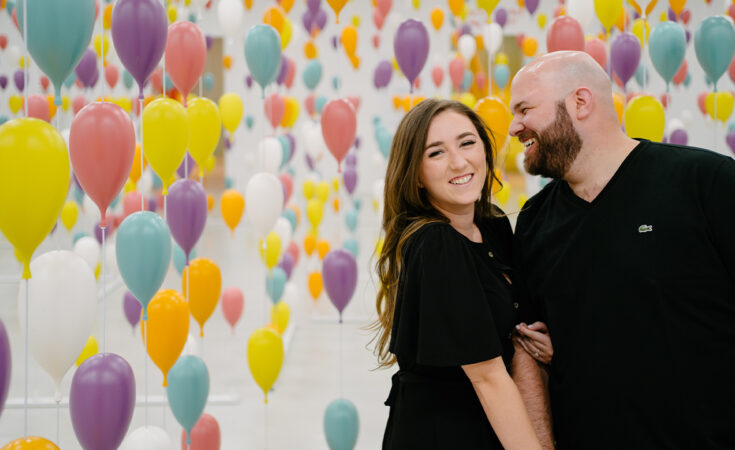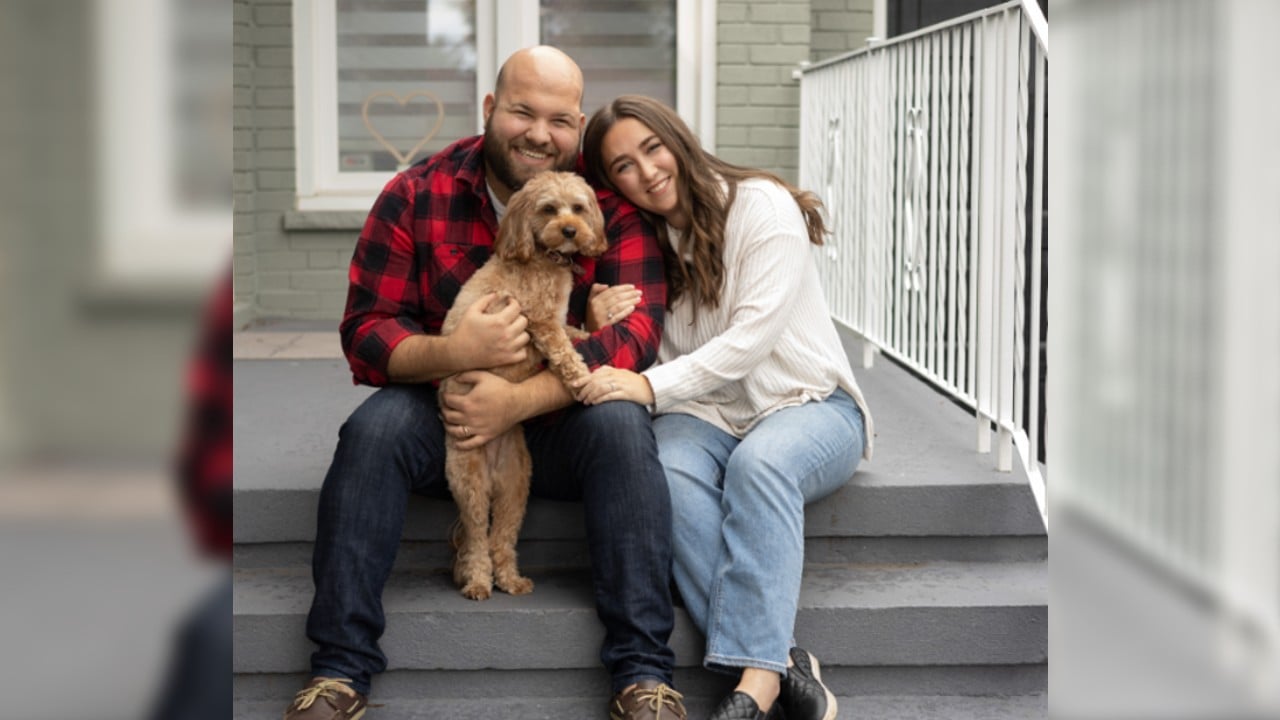Surrogacy was a lonely journey. Building a community on social media changed everything.
If someone told me years ago that Instagram would become one of the most important tools in my baby-making journey, I would have laughed at them. Until recently, my Instagram feed was mostly my lunch, vacation highlights and photos of my dog. That changed dramatically when my husband and I decided we were ready to have children.
We always knew having kids would be a very different process for us. As someone with a chronic health condition, I take daily medication to keep me safe and healthy. Taking my twice-daily pills allows me to live a life full of opportunity—I work, I travel and I enjoy life to its fullest. The only thing I can’t do? Be pregnant.
The medication I take isn’t pregnancy-safe, and coming off of it isn’t an option without life-threatening risk. Accepting that I would never carry a baby was complete heartache. I felt less than, and it seemed like everything existed to remind me that an integral part of my womanhood was missing. I tried desperately to come off of my medication despite major health ramifications and cried more tears than I’d like to admit. Accepting that I would never be pregnant crushed me. Then I learned about surrogacy.
My husband and I started researching much the same way everyone does, on Google. What we found left us almost more confused than before. Surrogacy isn’t a common way to build a family, and so resources felt scarce. We learned there was a name for people like us—”intended parents”—but also quickly discovered that there was no intended parent guide to follow, and much of the information we scrounged together was conflicting or out of date. We knew we needed more than we were getting from online searches, so we started searching hashtags like #canadiansurrogacy and #surrogacyincanadareaching, and reaching out to other intended parents and surrogates directly to ask for clarity. The approach felt awkward and clumsy, and direct messaging strangers put me way outside of my comfort zone.
The world of infertility, particularly surrogacy, is one of extreme kindness. Most of the women I reached out to responded, and many of them even became good friends who I’ve met and see in person. Each shared a unique perspective coloured by their own experiences and challenged me to see surrogacy in a whole new light.
I found out quickly that most of what people think they know about surrogacy from the media is wrong—typically sensationalized for TV or based on the American model of surrogacy. For example, Canada’s surrogacy community and laws are based on a theme of altruism. Surrogates can be reimbursed for their pregnancy-related costs and post-natal care, but cannot profit. Nothing about surrogacy is transactional. Intended parents and the surrogates who carry for them form intense bonds, often becoming lifelong friends or an extended family of sorts. This is in stark contrast to everything I’d read or seen on television and in movies but immediately felt right to me. How could you not have all the love in the world for a woman willing to carry your child? After learning these decidedly Canadian surrogacy facts, we felt reassured that this was the path for us.
Conversations with my new surrogacy friends had taught me to expect a long road ahead. Some hopeful parents spend years searching for a match. They employ all manners of tactics from working with surrogacy agencies, posting online search ads or appealing to members in local Mommy groups or newspapers. We knew that if we wanted to meet ‘Ms. Right’, we would need to do something different. While considering how we could separate ourselves from the crowd, another idea began brewing. We had learned so much from the individuals willing to privately share their journeys with us; what if we could pull the curtain on this entire process from the very beginning and blog the entire thing? Figuring that other intended parents might find it helpful, we launched our blog Not My Tummy (But I’m Still Mummy) and Instagram @NotMyTummy.
From the beginning, the blog and Instagram had two purposes. First, to create a chronicle of the entire journey to act as a guide for others who might need it. Second, to give a potential surrogate a chance to learn more about us. We posted about our likes, dislikes, hobbies and what we were hoping for in a match.
Messages began to pour in from around the world from couples who, like us, were seeking to begin a surrogacy journey in Canada and wanted to know where to start. We weren’t experts, and we told them as much, but they’d ask to jump on Zoom calls so we could share what little we had learned with them. In a space that ordinarily feels soul-crushingly isolating, we began to find people like us. Forming friendship out of shared experience is always wonderful, but making friends with people who truly get your infertility—that’s life-changing. The community of support around us began to feel transformative, and by fall it was tangibly so: Our story went viral on Instagram.
The author with her husband and their dog. Photo: Courtesy of Elyte Barzilay, Elyte Studio
It feels surreal to think back on the moment. I convinced my husband, the man who rarely even likes his photo taken, to snap and wiggle for the camera as I filmed an Instagram Reel. On it, I superimposed text with information about becoming our surrogate. We pushed “publish” and left the rest to the algorithm. Our account may have had 700 followers then, probably less, and today that video has reached over 630,000 people. This was only the first of our videos to take off.
It still blows me away to think that when people saw our story online they wanted to help. And boy did they help! Despite some false starts, one of our videos ultimately helped us reach our goal. Our surrogate Ashley found us right on Instagram while doing her daily scrolling and reached out to us through our direct messages. We are ecstatic and hoping for an embryo transfer in the coming months. The friendship we’ve built with her and her husband feels like something out of a (very unusual) storybook. For all the nights I cried, and moments my husband and I wondered if parenthood was ever going to be a reality, it feels like it was all leading to this. Our prayers were answered and then some. Ashley and her husband are kind, selfless and incredibly funny people. They are fantastic parents to their children and role models on generosity of spirit for any person, young or old.
I am eternally grateful to Instagram for being the platform to unite us and to the hundreds of thousands of people who have watched our videos or read our blog so far who have all contributed to this match happening. My parents always told me not to meet strangers off the internet, but I’m so glad that I tuned that out.
Baden Colt is an intended mother building her family through surrogacy. She can be reached through the Not My Tummy (But I’m Still Mummy) blog and @notmytummy on Instagram.
Stay in touch
Subscribe to Today’s Parent’s daily newsletter for our best parenting news, tips, essays and recipes.
= 0;if(!is_postback){return;}var form_content = jQuery(this).contents().find(‘#gform_wrapper_13’);var is_confirmation = jQuery(this).contents().find(‘#gform_confirmation_wrapper_13’).length > 0;var is_redirect = contents.indexOf(‘gformRedirect(){‘) >= 0;var is_form = form_content.length > 0 && ! is_redirect && ! is_confirmation;var mt = parseInt(jQuery(‘html’).css(‘margin-top’), 10) + parseInt(jQuery(‘body’).css(‘margin-top’), 10) + 100;if(is_form){jQuery(‘#gform_wrapper_13’).html(form_content.html());if(form_content.hasClass(‘gform_validation_error’)){jQuery(‘#gform_wrapper_13’).addClass(‘gform_validation_error’);} else {jQuery(‘#gform_wrapper_13’).removeClass(‘gform_validation_error’);}setTimeout( function() { /* delay the scroll by 50 milliseconds to fix a bug in chrome */ jQuery(document).scrollTop(jQuery(‘#gform_wrapper_13’).offset().top – mt); }, 50 );if(window[‘gformInitDatepicker’]) {gformInitDatepicker();}if(window[‘gformInitPriceFields’]) {gformInitPriceFields();}var current_page = jQuery(‘#gform_source_page_number_13’).val();gformInitSpinner( 13, ‘https://www.todaysparent.com/wp-content/plugins/gravityforms/images/spinner.gif’ );jQuery(document).trigger(‘gform_page_loaded’, [13, current_page]);window[‘gf_submitting_13’] = false;}else if(!is_redirect){var confirmation_content = jQuery(this).contents().find(‘.GF_AJAX_POSTBACK’).html();if(!confirmation_content){confirmation_content = contents;}setTimeout(function(){jQuery(‘#gform_wrapper_13’).replaceWith(confirmation_content);jQuery(document).scrollTop(jQuery(‘#gf_13’).offset().top – mt);jQuery(document).trigger(‘gform_confirmation_loaded’, [13]);window[‘gf_submitting_13’] = false;}, 50);}else{jQuery(‘#gform_13’).append(contents);if(window[‘gformRedirect’]) {gformRedirect();}}jQuery(document).trigger(‘gform_post_render’, [13, current_page]);} );} );]]>
Read The Full Article Here




































